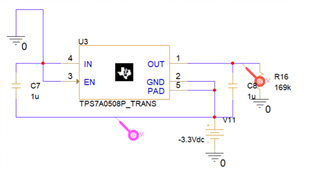Other Parts Discussed in Thread: TPS723, LM337
Hi Team,
can you please check the request of my customer:
--------------------------------------------------------------------
We have a -3.3V supply and need to produce a -2.5V rail out of it. We want to use an LDO to minimize the noise and ripple. The idea is using the TPS7A0508P as seen below:

As you see we don't connect the GND pin off the chip to our ground. Instead we connect it to -3.3V. And instead of connecting the pin IN to a voltage, we connect it to our ground.
* Does this work with TPS7A05?
* What does the customer has to consider to realize it?
* Is there anything what can be improve here.
Thanks
Jan

